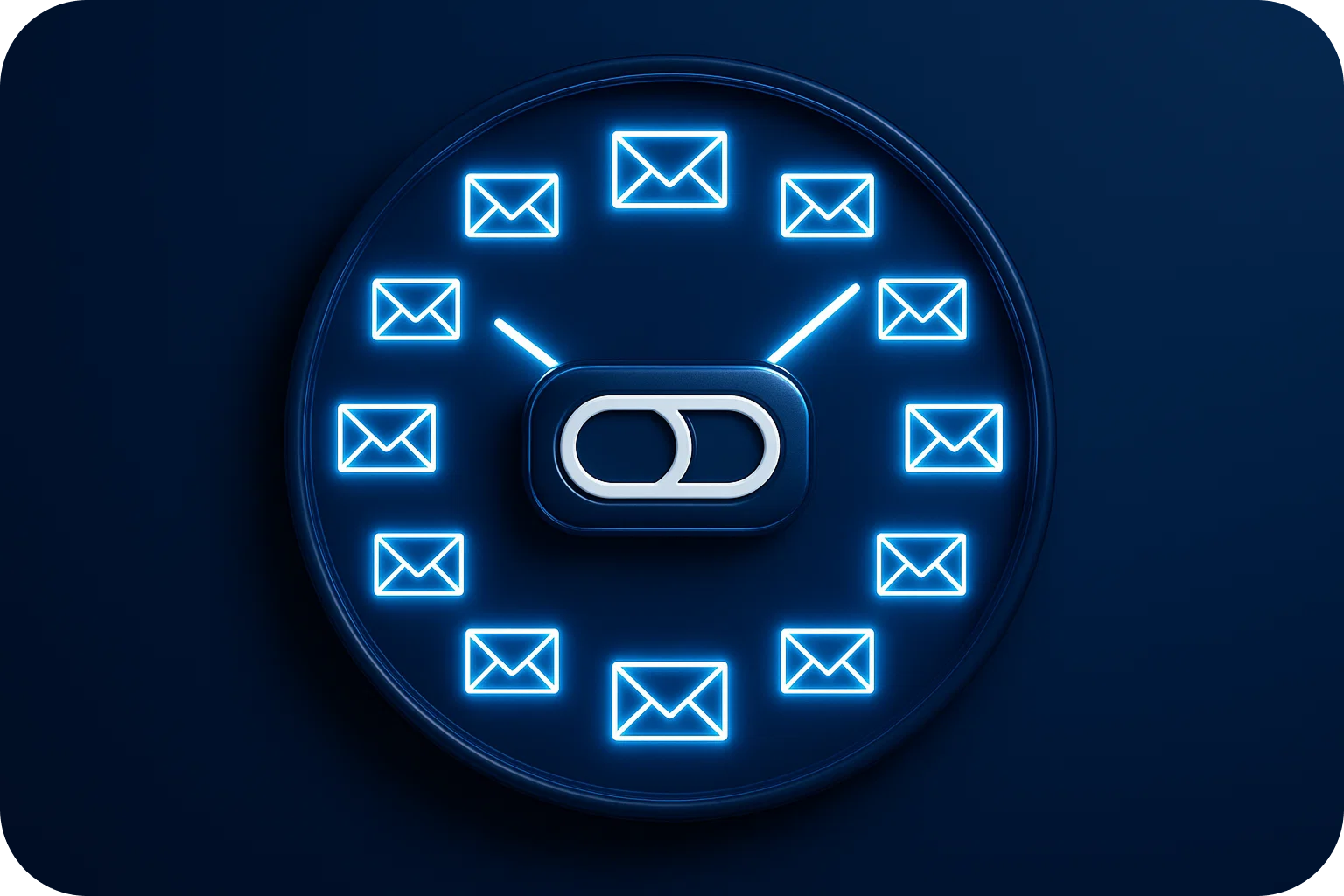Why Your Best Prospects Never See Your Follow-Ups (The Gmail Tab Problem)
.png)
You've crafted the perfect cold email sequence. Your first message gets a decent open rate. But then... crickets. Your follow-ups seem to vanish into thin air.
Here's the uncomfortable truth: Your prospects aren't ignoring you, they literally never see your emails.
Welcome to the Gmail tab problem, the silent killer of cold email campaigns that costs sales teams thousands of qualified conversations every month.
The Invisible Wall Between You and Your Prospects
Gmail processes over 1.8 billion users worldwide, and most of them never venture beyond their Primary tab. When your follow-up emails land in Promotions or Updates, they might as well not exist.
The data is sobering: emails in the Primary tab see open rates 2-3x higher than those relegated to Promotions. For cold outreach campaigns, this difference isn't just a metric; it's the difference between a booked meeting and a lost opportunity.
Why does this matter for your follow-ups specifically?Gmail's filtering algorithm learns from each interaction. Even if your first email squeaks into Primary, subsequent messages face increasingly aggressive scrutiny. One wrong signal, a tracking pixel, a suspicious link, inconsistent sending patterns, and your entire sequence gets rerouted away from your prospect's attention.
How Gmail Actually Decides Where Your Email Goes
Understanding Gmail's tab system isn't about gaming an algorithm. It's about aligning your infrastructure and content with how modern email clients protect their users.
The Three Factors Gmail Evaluates
1. Sender Reputation and Infrastructure
Your domain's sending history matters more than your message content. Gmail examines:
- Domain age and consistency: New domains or sudden volume spikes trigger filters
- Authentication protocols: Proper SPF, DKIM, and DMARC configuration signals legitimacy
- IP reputation: Shared IPs with poor senders contaminate your deliverability
- Bounce rates and complaints: High numbers permanently damage your sender score
This is why companies scaling cold outreach hit a wall. You can't simply add more domains and expect the same inbox placement. Each domain needs proper warm-up, authentication, and volume management.
2. Engagement Patterns
Gmail watches how recipients interact with your emails:
- Open rates across your domain: Low engagement signals unwanted mail
- Reply rates: Conversations indicate legitimate business communication
- Time to deletion: Emails deleted without opening hurt future placement
- Spam complaints: Even a small percentage tanks your reputation
Your follow-up sequence faces a compounding challenge. If prospects don't engage with message one, Gmail assumes they don't want message two, three, or four either.
3. Content and Technical Signals
Certain elements immediately flag promotional content:
- Tracking pixels and link redirects: These scream "marketing automation"
- Image-to-text ratio: Heavy image content suggests promotional material
- Promotional language: Discount codes, urgent calls-to-action, and sales-heavy copy
- Inconsistent sending patterns: Bulk sends at odd hours raise red flags
Why Your Follow-Ups Suffer Most
Your initial cold email might land in Primary through careful crafting and good timing. But follow-ups face a steeper climb.
The Engagement Cliff
When a prospect doesn't open or reply to your first email, Gmail notes that lack of engagement. Your second email now carries that negative history. By your third or fourth follow-up, Gmail's confidence that this is unwanted mail approaches certainty.
This creates a vicious cycle: lower placement leads to lower engagement, which leads to even lower placement for subsequent messages.
The Volume Problem
Most sales teams send follow-ups in batches, Monday morning, Wednesday afternoon, Friday before lunch. This predictable pattern, multiplied across dozens or hundreds of prospects, creates exactly the kind of bulk sending behavior Gmail's filters target.
The Infrastructure Strain
Scaling cold outreach means more domains, more inboxes, and more complexity. Without proper management:
- DNS records become inconsistent across domains
- Some inboxes get overused while others sit idle
- Warm-up schedules get neglected during growth phases
- Authentication breaks during technical migrations
Each infrastructure weakness compounds across your follow-up sequence, progressively degrading placement.
The Real Cost of the Promotions Tab
Let's quantify what poor inbox placement actually costs your pipeline.
Assume you're running a modest cold email campaign:
- 1,000 prospects per month
- 4-email sequence
- 40% Primary tab placement (industry average for cold email)
- 25% open rate in Primary, 8% in Promotions
Emails reaching Primary: 1,600 (40% of 4,000 total emails)
Opens from Primary: 400
Emails in Promotions: 2,400
Opens from Promotions: 192
You're losing 208 potential opens every month—a 52% reduction in visibility. If your reply rate is 10% of opens, that's 21 lost conversations monthly, or 252 qualified conversations annually.
At a 20% meeting-to-close rate and $10,000 average deal size, the Gmail tab problem costs you $504,000 in annual revenue.
Strategies to Land in Primary (and Stay There)
Fixing inbox placement isn't about tricks or hacks. It's about building legitimate sending infrastructure and creating content prospects actually want to receive.
1. Build Proper Email Infrastructure
Authenticate everything: Ensure SPF, DKIM, and DMARC records are correctly configured across all sending domains. Use tools to verify these records are actually working, not just present.
Warm up systematically: New domains and inboxes need 3-4 weeks of gradual volume increase before full-scale sending. Start with 20 emails per day per inbox and increase by 5-10 daily.
Manage sending volume: Never exceed 100 emails per inbox per day, and keep domains to 3-5 inboxes maximum. Scaling means adding properly configured domains, not overloading existing ones.
Monitor deliverability metrics: Track inbox placement rates, not just delivery rates. An email "delivered" to Promotions is functionally undelivered.
2. Optimize Content for Engagement
Write like a human: Avoid marketing language, excessive formatting, and promotional phrases. Your email should read like a personal message from one professional to another.
Remove tracking when possible: Every tracking pixel is a signal that this is bulk mail. Consider tracking only opens on the first email, or use server-side tracking that doesn't require pixels.
Personalize meaningfully: Generic merge tags aren't personalization. Reference specific details about the prospect's company, role, or recent activity that demonstrates genuine research.
Encourage replies: Ask questions, invite feedback, and make responding easy. Gmail rewards two-way conversations with better placement.
3. Sequence Strategy Matters
Space follow-ups appropriately: Wait 3-5 days between messages. Aggressive follow-up cadences trigger bulk mail filters.
Vary send times: Don't send all follow-ups at 9 AM on Tuesdays. Randomize sending times within business hours to mimic natural communication patterns.
Adjust based on engagement: If someone opens but doesn't reply, your next message should acknowledge that interest. If there's zero engagement, consider whether continuing the sequence serves anyone.
Test different approaches: A/B test follow-up content, timing, and sender addresses to identify what drives engagement in your specific market.
4. Use Professional Email Providers
Gmail Workspace and Microsoft 365 carry inherent trust that shared IP providers can't match. While more expensive per inbox, the deliverability advantage often justifies the cost.
Dedicated IPs give you complete control over sender reputation, crucial for high-volume senders who can't afford to share reputation with unknown senders.
Avoid cheap alternatives: Budget email providers often use shared infrastructure with poor reputation, contaminating your deliverability from day one.
The Infrastructure Advantage
Companies that consistently land in Primary don't have better copywriters; they have better infrastructure.
Mailpool customers achieve 96-98% inbox placement rates because infrastructure is managed systematically: proper authentication, volume management across domains, and provider diversity that matches your specific needs.
When your follow-ups actually reach Primary, your entire campaign economics change. Higher visibility drives more conversations, which improves engagement signals, which further improves placement. Success compounds.
Your Follow-Ups Deserve to Be Seen
The Gmail tab problem isn't insurmountable, but it requires treating email infrastructure as seriously as you treat your message content.
Every follow-up that lands in Promotions is a qualified conversation you'll never have. Every sequence that progressively degrades in placement is revenue leaking from your pipeline.
The solution isn't sending more emails or writing better subject lines. It's building infrastructure that earns Primary tab placement and maintaining the technical discipline to keep it.
Your prospects are out there. They might even want what you're selling. But first, you need to reach their inbox.
More articles
Get started now




%201.png)




.png)
